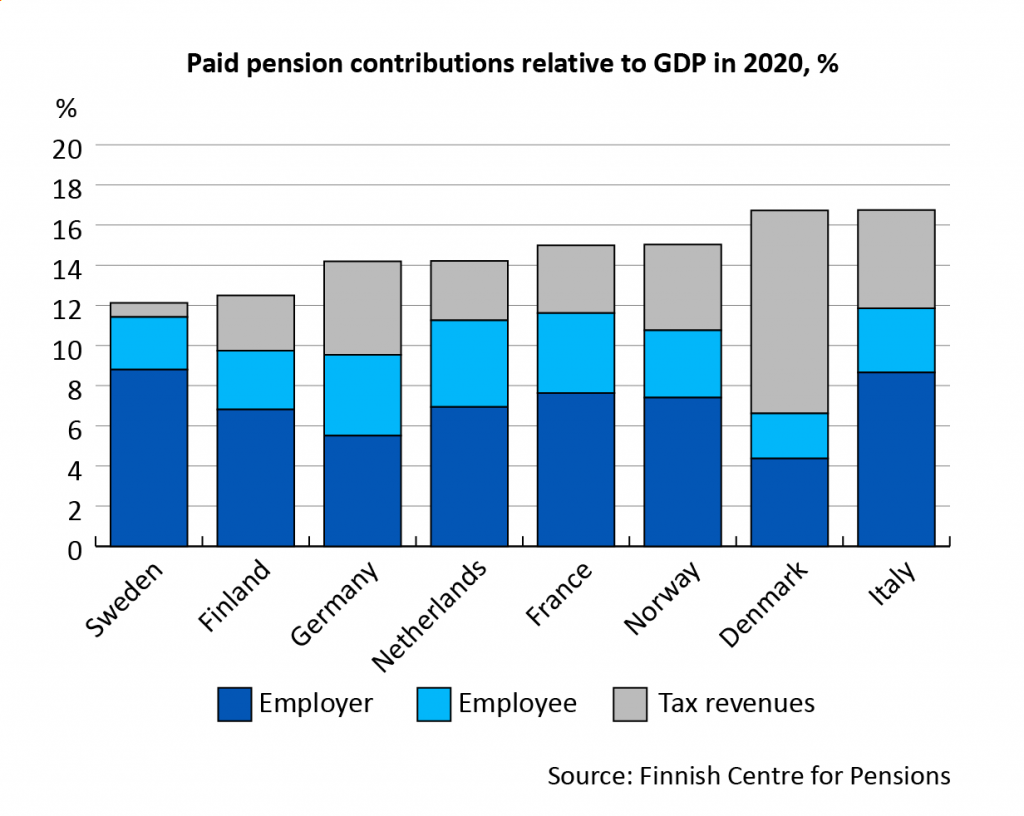Cross-national comparison of pension costs reveals: Lowest contribution levels in Sweden and Finland

The Finnish Centre for Pensions compared pension contribution levels in eight European countries. Pensions cost the least in Sweden and Finland, just over 12 per cent relative to GDP. The highest price tag on pensions is found in Italy and Denmark. Employers pay the main part of pension contributions in all other countries except Denmark.
Eight countries are included in the pension contribution comparison: Denmark, Finland, France, Germany, Italy, the Netherlands, Norway and Sweden.
The comparison covers all contribution income paid by employees, employers, the self-employed and the State in 2020.
Pensions were the least expensive in Sweden and Finland, where the contribution income for pensions was just over 12 per cent of GDP. They were the most expensive in Italy and Denmark, nearly 17 per cent of GDP. On average, the contribution income equalled more than 14 per cent of GDP.
“The comparison provides a good overall picture of the price of pensions in the countries included in the comparison, regardless of the structural differences in pension provision. If only statutory contributions were compared, Finland’s contribution level would seem much higher,” says Liaison Manager Mika Vidlund (Finnish Centre for Pensions).
Finland and Sweden prepared for ageing population
Many things affect the contribution level: population structure, use of pension assets, pension levels and effective retirement age.
Sweden and Finland have prepared for an aging population by funding part of the pension contributions. In addition, Finns have deferred retirement considerably in the 2010s. All countries included in the comparison have curbed the growth of pension expenditure by adjusting pensions to the change in life expectancy.
The price tag for Sweden and Finland is smaller also because of the pension benefit levels in these two countries: they are EU average but smaller than in most other countries included in the comparison. Denmark and Italy are at the other end of the scale.
“The Danish national pension, financed by the State, is generous and paid to all. The high Italian contribution level is explained by an ageing population, high benefits and limited funding”, explains Senior Adviser Antti Mielonen (Finnish Centre for Pensions).

Employers pay the lion’s share
With the exception of Denmark, employers pay the largest share of pensions in all countries included in the comparison.
On average, employers finance half of the contribution income, employees 20 per cent and tax revenues the remaining 30 per cent.
In Finland and Sweden, the financing of pensions relies heavily on pension contributions. In Germany and Italy, the contribution base for occupational pensions has been broadened by increasing the share of tax revenues, which lowers the pension contributions required from employers and employees.
Cross-national comparison of pension contribution levels
- covers total pensions (that is, statutory minimum and occupational pensions) in eight European countries;
- does not cover voluntary individual pension insurance;
- consists of contribution income from employers, employees and self-employed persons, as well as from tax revenues, relative to GDP and wages; and
- is based on data from 2020 which have been collected from national statistics as well as EU and OECD data.

